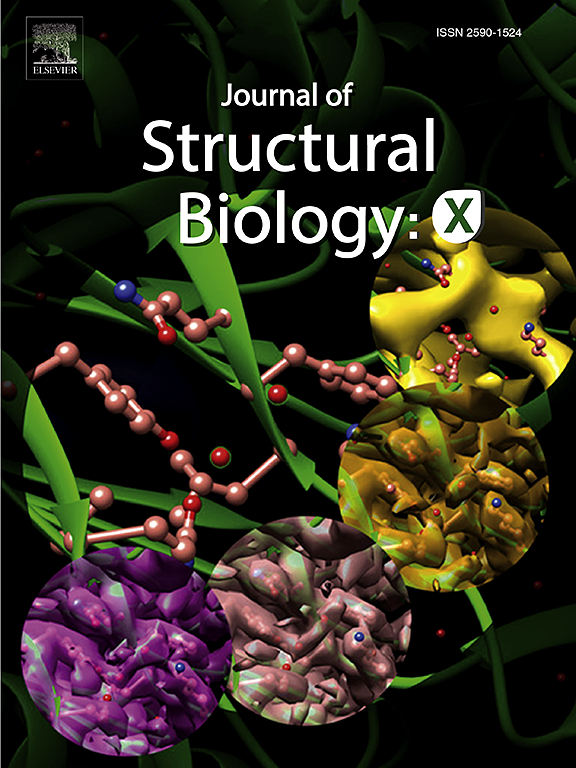JBP1 和 JBP3 的结构一致,但与碱基-J 的亲和力不同。
IF 2.7
3区 生物学
Q3 BIOCHEMISTRY & MOLECULAR BIOLOGY
引用次数: 0
摘要
碱基- j (β-D-glucopyranosyloxymethyluracil)是一种不寻常的着丝质体特异性DNA修饰,由含有碱基- j的DNA (J-DNA)结合蛋白JBP1和JBP3识别。JBP1和JBP3通过一个保守的J-DNA结合域(JDBD)识别J-DNA。研究表明,JDBD-JBP3对碱基j的亲和力比JDBD-JBP1弱约1000倍,区分J-DNA和未修饰DNA的因子为 ~ 5,而JDBD-JBP1区分J-DNA的因子为 ~ 10,000。本文将JDBD-JBP3的晶体结构与先前表征的JDBD-JBP1的晶体结构进行了比较,发现JDBD-JBP3中缺少带正电荷的斑块,具有柔性α5-螺旋结构。在JDBD-JBP1中去除该正电荷的突变导致与野生型JDBD-JBP1的结合亲和力降低,表明该补丁参与DNA结合。我们认为α5-螺旋可能在JBP1与J-DNA结合后重排,从而稳定了复合物。这项工作有助于我们了解jbp如何与这种独特的DNA修饰结合,这可能有助于确定潜在的药物靶点,以结束依赖碱基j的寄生虫生命周期。本文章由计算机程序翻译,如有差异,请以英文原文为准。

JBP1 and JBP3 have conserved structures but different affinity to base-J
Base-J (β-D-glucopyranosyloxymethyluracil) is an unusual kinetoplastid-specific DNA modification, recognized by base-J containing DNA (J-DNA) binding proteins JBP1 and JBP3. Recognition of J-DNA by both JBP1 and JBP3 takes place by a conserved J-DNA binding domain (JDBD). Here we show that JDBD-JBP3 has about 1,000-fold weaker affinity to base-J than JDBD-JBP1 and discriminates between J-DNA and unmodified DNA with a factor ∼5, whereas JDBD-JBP1 discriminates with a factor ∼10,000. Comparison of the crystal structures of JDBD-JBP3 we present here, with that of the previously characterized JDBD-JBP1, shows a flexible α5-helix that lacks a positively charged patch in JBP3. Mutations removing this positive charge in JDBD-JBP1, resulted in decreased binding affinity relative to wild-type JDBD-JBP1, indicating this patch is involved in DNA binding. We suggest that the α5-helix might rearrange upon JBP1 binding to J-DNA stabilizing the complex. This work contributes to our understanding of how JBPs bind to this unique DNA modification, which may contribute to identifying potential drug targets to end the base-J dependent parasite life cycle.
求助全文
通过发布文献求助,成功后即可免费获取论文全文。
去求助
来源期刊

Journal of structural biology
生物-生化与分子生物学
CiteScore
6.30
自引率
3.30%
发文量
88
审稿时长
65 days
期刊介绍:
Journal of Structural Biology (JSB) has an open access mirror journal, the Journal of Structural Biology: X (JSBX), sharing the same aims and scope, editorial team, submission system and rigorous peer review. Since both journals share the same editorial system, you may submit your manuscript via either journal homepage. You will be prompted during submission (and revision) to choose in which to publish your article. The editors and reviewers are not aware of the choice you made until the article has been published online. JSB and JSBX publish papers dealing with the structural analysis of living material at every level of organization by all methods that lead to an understanding of biological function in terms of molecular and supermolecular structure.
Techniques covered include:
• Light microscopy including confocal microscopy
• All types of electron microscopy
• X-ray diffraction
• Nuclear magnetic resonance
• Scanning force microscopy, scanning probe microscopy, and tunneling microscopy
• Digital image processing
• Computational insights into structure
 求助内容:
求助内容: 应助结果提醒方式:
应助结果提醒方式:


